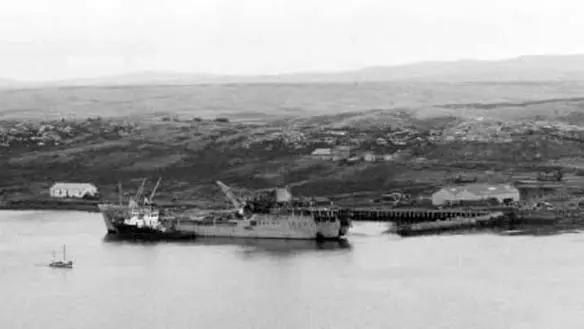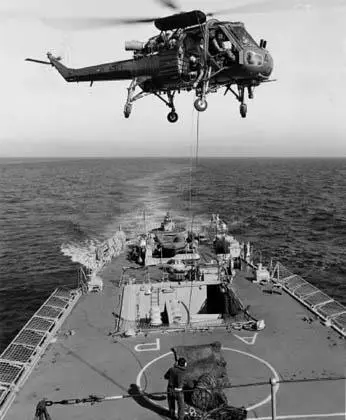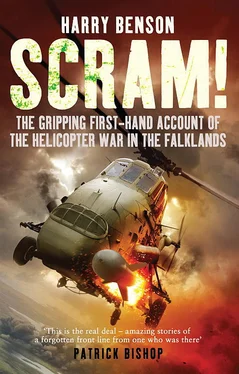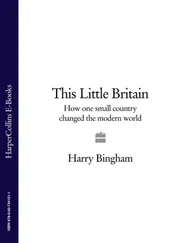Interestingly, one of the Pucaras was shipped back from the Falklands to the test pilot school at Boscombe Down. The following summer, Simon Thornewill managed to fly the Pucara twice, discovering a little secret that dispelled some – but only some – of its mystique. At slow speed (below ninety knots) the Pucara handling was not half as manoeuvrable as we’d feared. It would have been nice to have known this during the war.
I have three emotional memories of life at Navy Point. The first was the Falklands wind. It blew through my ears and knocked me off balance so much that I felt physically sick. The second was the showers on board the RFA Sir Tristram . After the attack at Port Pleasant a few weeks earlier, the half-burnt, half-intact ship was towed around to Navy Point. I had mixed feelings every time I walked on board. I would come out clean on the outside but with the terrible smell of burning seared inside my head. The smell still lingers with me today, decades later.

After the war, we moved our base from Port San Carlos to Navy Point, opposite Port Stanley. I spent three months there. The bombed-out ship Sir Tristram had been towed around from Port Pleasant. Wandering onboard for a shower posed a real dilemma. The showers were brilliant but the smell of burning was sickening.
The third and worst memory concerned an appalling accident at Port Stanley airport a month after the war. A group of Welsh Guards were clearing snow from the airfield when a taxiing Harrier inadvertently released two Sidewinder air-to-air missiles. Sidewinder has only a small explosive charge in its head; it’s the expanding wire, designed to cut through the controls of the target aircraft, that does the damage. The missile flew straight at the Guardsmen, causing terrible injuries to eleven. Within minutes my colleagues were casevacing the dreadfully wounded soldiers to field hospitals and hospital ships, our aircrewmen trying to staunch the flow of blood en route.
The following day I was sitting in my cockpit on the deck of SS Uganda . A stretcher was brought out with one of the casualties, a healthy-looking Welsh Guardsman, wrapped under a silver survival blanket. I was about to take him to the airport to be flown home in a Hercules. The downdraft from my Wessex lifted his blanket to reveal that both his legs had been amputated. The war had finished and I had relaxed my guard. I simply wasn’t ready for the shock. I retched.
On my final day in the Falklands, I flew gratefully out to the troopship MV Norland , which had brought my 845 Squadron colleagues to relieve us. As I sat in the hover alongside the ship in San Carlos Water, my air-speed indicator read fifty-five knots of wind. I was very pleased indeed to be going home. Three months after the war ended, I flew the 8,000 miles back to UK via Hercules to Ascension and VC-10 to Brize Norton and a wonderful but small family reception.
After a few weeks leave, most of my colleagues rejoined 845 Squadron, having discovered that 847 Squadron had been disbanded. We were promptly despatched to Northern Norway for Arctic training. It would be my third winter in a row. At least Hector had returned to the warmth of Ascension. But if you can’t take a joke, went the well-known military refrain, you shouldn’t have joined.
June 2007. A bunch of us arranged to meet up in a Whitehall pub the night before the twenty-fifth anniversary parade down the Mall. I was looking forward to it but also felt apprehensive. I had been out of the junglie loop since completing my first tour on 845 and 847 Squadrons at the end of 1983. I’d spent my second tour as flight commander of the frigate HMS Apollo flying an 829 Squadron Wasp. It was a responsible job for a young pilot. But it put me totally out of contact with the rest of the Fleet Air Arm.

After flying a Wessex, my second job was flying this Wasp helicopter from the frigate HMS Apollo . The Wasp is the naval version of the Army Scout. During the Falklands War, three Wasps like this one fired several AS12 missiles in a vain effort to sink the Argentine submarine Santa Fe in South Georgia. Unfortunately the fin of a submarine is hollow.
After these two tours, I left the Royal Navy altogether to pursue a career in business in the Far East. Now I was back in the UK running a charity. I’d only kept in touch with a few former junglies who told me about the parade and the meet. I felt a little unsure of my welcome. As I walked in, I could see someone at the far side of the pub wearing a baseball cap. ‘Sparky?’
‘Harry!’
It was bloody brilliant to see an old friend. He’d been even more apprehensive than I was about meeting up again. Having been court-martialled and kicked out of the Navy after his crash in Norway, he thought he might be shunned. No chance.
In walked some of the other guys. I wasn’t sure if anyone recognised him. ‘Do you know who this is, Hector?’ He shook his head. ‘It’s Sparky.’ Tears welled up for all of us. The three of us had been in the same house at Dartmouth together. It was a great moment. Then the beer flowed and we were off, sharing an extraordinary array of war stories.
I suddenly realised that between us we’d been involved with almost every major incident of the war, barring the Belgrano sinking. Pete Manley told us about his AS12 strike on the police station with Arthur Balls. Whatever happened to Arthur, we asked? Another lovely man. No one knew. I was astonished to hear Hector’s amazing story about his Mirage strafing and Ardent rescue on D-Day. I had no idea. Jack Lomas reminisced about the FOB at San Carlos and Oily Knight’s brush with two Tigercat missiles and a bullet through the windscreen. So that was what happened to Yankee Tango, I thought. We laughed until it hurt when we heard that Oily had got his comeuppance just before going home. He lost the very last game of ‘spoof’ at Port San Carlos and was made to eat a giant ration pack tin of greasy cold steak-and-kidney pudding, charmingly known to all as ‘baby’s heads’.
I told my own story about coming under fire on Mount Longdon with Andy Pulford. I learnt that he was now Air Vice-Marshal Pulford RAF – Wow! Everyone agreed with Jerry Spence when he admitted he had found flying in the hills at night far worse than being shot at. And Mike Tidd talked about his amazing crash and rescue on Fortuna Glacier.
The war seems to have affected us all in different ways. Most of us are fine about it. I think either the long journey home by sea or the long stint as garrison in the Falklands gave us time to process what we had seen and done. Several found it harder than they expected being interviewed for this book.
A few colleagues still feel aggrieved about management. Even if Jack Lomas did a great job as senior flight commander, there was no Wessex squadron commanding officer or senior pilot on the ground in the Falklands until a week from the end, when Engadine turned up. Even if we did a huge amount of useful work, Wessex tasking was impromptu to non-existent at times. We often arrived for an assigned task only to discover some other cab was already on it. On occasion, valuable crews and aircraft sat unused and frustrated in San Carlos Water. Some of the early operating practices, such as routinely exceeding power limits, were questionable. Had the burnt-out remains of a Wessex and its crew been found some distance from its rotors and gearbox, these practices would not have seemed so wise.
Читать дальше














